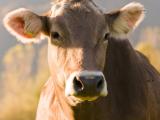Jan 28, 2005 (CIDRAP News) – Canada's investigation of its second case of bovine spongiform encephalopathy (BSE) recently concluded with a finding that at least 110 cattle in the infected cow's birth group died or were slaughtered before that case came to light.
Although those cattle might have been exposed to feed that contained infective material, the Canadian Food Inspection Agency (CFIA) said they represent very little risk to public health. The few cattle from the birth cohort that were still living were tested and found to be free of BSE, or mad cow disease.
The CFIA said BSE prevalence in Canada is low, and most cattle are slaughtered before they are old enough to have infective levels of BSE. Also, BSE studies in a number of countries have shown that finding more than one case of BSE in a birth cohort is rare.
The end of the case investigation was announced Jan 21. Investigation of Canada's third BSE case, which was disclosed Jan 11, is still under way.
The second case was in a Holstein cow in northern Alberta that was found unable to walk on Dec 17, 2004. Euthanization and testing led to the confirmation of BSE in the cow on Jan 2.
Investigators determined that the cow had been born in October 1996 and had been given feed containing cattle meat-and-bone meal in the spring of 1997. Later that year, as a BSE precaution, both Canada and the United States banned the practice of putting protein from cattle and other ruminant animals into feed for ruminants.
Investigators also found that the cow's birth cohort—cattle born on the same farm and within 1 year before or after it was born—numbered 135 animals. Nine of these were found to be still living; they were euthanized and subsequently tested negative for BSE. Of the other 126 cattle, the CFIA determined that:
- Five had died of causes unrelated to BSE on the original farm
- 110 had died elsewhere or had been slaughtered
- Six had been exported to the United States for slaughter
- Four were untraceable because of missing records
- One had tested negative for BSE in November 2004 as a result of routine BSE surveillance
In describing any health risk related to the cow's birth cohort as low, the CFIA said, "The prevalence of BSE in North America is low and the vast majority of cattle slaughtered in Canada are young cows, considerably less likely to develop infective levels of the disease. All cattle exhibiting symptoms consistent with BSE have been, and continue to be, diverted from the food system."
The agency also said, "Finding more than one case of BSE in a birth cohort is rare. This has been consistently shown internationally, even in the United Kingdom during the height of their BSE epidemic. It has also been demonstrated in all investigations completed to date in North America."
The infected cow had had calves in 2003 and 2004, and the investigation determined that both had died of causes unrelated to BSE, the CFIA said.
The agency also concluded that the amount of BSE infectivity in the feed the cow consumed was probably very small, because the cow didn't become visibly ill until it was 8 years old. A long incubation time implies that the dose of infective material was small, the statement indicated.
Concerning the third BSE case, the CFIA said on Jan 21 that 33 cattle from the infected cow's birth cohort had been tested and found to be free of BSE. The animal was an Alberta beef cow just under 7 years old.
The agency said it had begun reviewing Canada's feed controls and would report the results by the end of February. It also said the US Department of Agriculture (USDA) and US Food and Drug Administration planned to review Canada's feed controls starting this week. The two reviews would, "where practical, proceed in concert," but are not explicitly linked, the agency said.
The USDA so far has stood by its plan to reopen the US border to live Canadian cattle in March. The agency banned the importation of live Canadian cattle when the first Canadian BSE case was discovered in May 2003. The two latest cases in Canada emerged shortly after the USDA announced the reopening plan, and some groups have called on the agency to postpone the move. The plan is to admit cattle that are under 30 months old and destined for slaughter before they reach that age.
















